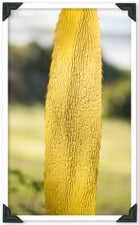Would you believe we've been harvesting Radiata without a chainsaw? Eklonia Radiata that is, otherwise known as common kelp. Seaweed is rich in minerals and proteins that we need for good health and all those goodies are bundled up in a form that our bodies find easy to absorb.
But why are so many of us squeamish when it comes to harvesting our ocean's bounty? Well if you grew up anything like I did, chances are it wasn’t on the weekly menu.
It was called a weed back then, not a sea vegetable as it is now. When I gathered it as a kid, it was by the trailer load and we selected the slimiest, smelliest bull kelp (Durvillaea Antarctica) we could find, for digging into the garden.
Eating it was the last thing on our minds, although the honeycomb interior of the thick leathery leaves did make great pretend crumpets.
I’m from Kaikoura and it turns out that the deep, clean waters that run close to the rocky shore are home to some of the richest and tastiest varieties of seaweed found anywhere in the country. Eklonia Radiata or Butterfish Kelp as we call it grows in large forests anchored to rocky sea beds. It can grow very long fronds that get torn from the plant during seasonal storms.
Just after one of those storms is the best time to find fresh kelp, adrift in the shallows or washed ashore. You know it's fresh because it smells of the sea, not of rotten seaweed and it is shiny, firm and clean to the touch, not slimy and limp.
Before harvesting, check that there aren't restrictions to gathering in your area. Currently, you can't gather from my beloved Kaikoura coast as we are letting the ecosystem recover after the 2016 earthquakes. Likewise, harvesting from marine or customary reserves or from polluted areas isn't allowed. It's an easy google search to find out the rules.
To dry it: first, give it a good rinse in a lot of cold water and lay the strips out in a well-ventilated space for a couple of days. I put mine in my soil sieve in a sunny spot.
- When it is crispy, slice it up with a sharp knife. It is surprisingly tough for such a fragile-looking leaf.
- Stored away from the light, in a glass jar with an airtight lid it will keep for several months.
- It has a nice peppery, mineral flavour which goes well with fish and also in things like chicken soups and casseroles.

Have a dish of finely chopped dried kelp on the table to use as a salt replacement. If you’re on a reduced salt diet you may not be getting as much iodine as you need and seaweed is high in iodine with an interesting taste profile. Iodine keeps your thyroid functioning well which keeps your metabolism working and your weight balanced.
Seaweed has been an integral part of Māori cuisine for centuries. The knowledge of which varieties to gather, when and where from, as well as how to preserve and prepare it was known and passed down from generation to generation.
Japanese food culture is the same, with extensive use of different seaweeds, not just nori sheets around the sushi and wakame in the miso, but many different varieties used in both sweet and savoury dishes.
So now you know one of our edible native seaweed varieties, go pick some up next time you find yourself near the coast after a storm.
If you’re interested we might blog about some other more seasonal varieties of sea vegetables in the future.

